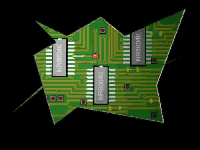
In order to be part of this activity, you must obtain an Amateur Radio License.
These days Amateur "Radio" includes things like orbiting satellite communications, "packet" (internet-like) radio using computers, actual contacts with US Space Shuttle or Russian MIR1 astronauts (if there is one who happens to be a ham aboard - which is quite frequent), and our specialty:
If you're NOT already a "HAM", you might be surprised at how easy it is to become one. Although Hams can be as knowledgable as electrical/electronics and/or computer engineers, most aren't. Many are everyday "Joes" and "Janes".
An entry-level "TECHNICIAN" class license (which requires no morse code ["CW"] training) can be obtained by anyone knowing minimal electronics theory and having an understanding of the pertinent rules. One local club offers courses and gives periodic exams.
Technicians are limited in several ways (you cannot use the "hf" frequencies for example) but can fully participate in all other activities mentioned above. Once "in" you will be encouraged to continue your studies (towards higher-level license classes), but there's no rigid timetable to worry about.
One thing we're not, though, is "CB'er's". As noted above, Amateur Radio is licensed and regulated. We take our hobby and responsibilities seriously.

QST magazine La Crosse Public Library has a subscription.
Ham Radio On-Line
Public, school and university libraries: Look for Amateur Radio titles.
NOTES:
73 Amateur Radio Today Magazine . Not as comprehensive as QST, but does sometimes have material not found there. > Current publication status uncertain (otherwise): On newsstands.
CQ and CQ - VHF Magazines. Same advice as 73 magazine.
BADGER STATE SMOKE SIGNALS Newspaper. By and for Wisconsin Hams. Notices of meetings, events & other useful tidbits. (Monthly)
SkyWarn - National Weather Service
1. Ham Radio provided back-up communications during the MIR emergency (CQ-VHF 9/97).
2. See QST 9/97 for a great article.
3. FSTV used during floods at Grand Forks, ND. Story & picture, QST 2/98.
4. FSTV and the Rose Bowl Parade. Story, QST 3/98.